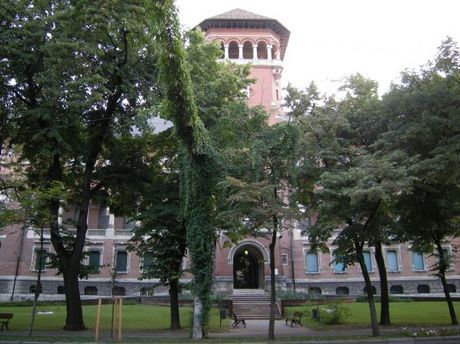Museum of Romanian Peasant
Founded by royal decree in 1936, this fascinating outdoor museum, the largest in Europe, covers some 30 acres on the shores of Lake Herastrau in Herestrau Park. It features a collection of 50 buildings representing the history and design of Romania's rural architecture. Steep-roofed peasant homes, thatched barns, log cabins, churches and watermills from all regions of the country were carefully taken apart, shipped to the museum and rebuilt in order to recreate the village setting.
The Museum of Romanian Peasant is the winner of the European Museum of the Year Award for year 1996. A short visit to the museum will convince you that the award is well deserved. The collection includes 18000 pieces of pottery and 20000 examples of national dress from all over the country, as well as carpets, icons, furniture, photographs and films documenting the customs of rural life. But what makes it special is the way the collection is arranged; the museum looks more like an art gallery than a museum. The display information is hand written on pieces of paper or illustrated by freehand sketches. In one of the galleries you can see a wooden church and in another a wooden peasant house. They also have some beautiful "troite" (crosses placed at crossroads or at the edge of a village).
The museum building has an interesting story as well. The museum was founded in 1905 under the name of Ethnographical and National Art Museum. In 1906 Carol I laid the foundation for the present building; the construction was stopped in 1916 and restarted in 1932. It was completed only in 1935, 29 years after it was started. The red-brick building is an illustration of the neo-Romanian style ispired from the traditional architecture. In 1953, the communists "liberated" the building and sent the collection away to another location. The building was turned into a museum dedicated to the history of the Communist Party. In 1990 the museum returned to its old location.
The Museum of the Romanian Peasant (Romanian: Muzeul Ţăranului Român) is a museum in Bucharest, Romania, with a collection of textiles (especially costumes), icons, ceramics, and other artifacts of Romanian peasant life. One of Europe's leading museums of popular arts and traditions, it was designated "European Museum of the Year" for 1996.
Located on Şoseaua Kiseleff, near Piaţa Victoriei, the museum falls under the patronage of the Romanian Ministry of Culture. Its collection includes over 100,000 objects.
First founded in the 1930s by and originally managed by Alexandru Tzigara-Samurcaş, the museum was reopened February 5, 1990, a mere six weeks after the downfall and execution of Nicolae Ceauşescu. During the Communist era, the building housed a museum representing the country's Communist party; the museum's basement still contains a room devoted to an ironic display of some artifacts from that earlier museum. The building, which uses traditional Romanian architectural features, was built on the former site of the State Mint (Monetăria Statului).
The museum was devastated during the June 1990 Mineriad, due to being confused with the headquarters of the National Peasants' Party.
One of the museum's most famous exhibits—originally the work of Tzigara-Samurcaş—is "the house in the house". The house, which originally belonged to peasant Antonie Mogos of Ceauru village in Gorj County. From the first, the house was displayed in a non-naturalistic way: objects that would normally be in the interior were displayed in various manners outside; outbuildings were suggested by fragments. The Communist regime displayed the house much more conventionally, outdoors at the Village Museum; it returned to the Peasant Museum in 2002. The current display at the Peasant Museum revives the original non-naturalistic approach. For example, from a platform, museum visitors may peer into the attic, part of whose wall is stripped away; various objects are arranged inside.
In 2002, the museum's exhibit space was greatly expanded as the museum store and offices moved into a new building behind the old one, freeing up a considerable amount of floor space in the museum proper.




